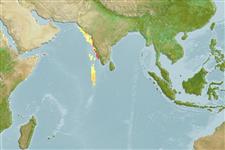Teleostei (teleosts) >
Eupercaria/misc (Various families in series Eupercaria) >
Sciaenidae (Drums or croakers)
Eponymy: Rev Dr Christoph Samuel John (1747–1813) was a botanist and herpetologist and a medical missionary (1771–1813) at the Danish trading station of Tranquebar (now Tharangambadi), Tamil Nadu, not far from Madras (Chennai). [...] (Ref. 128868), visit book page.
More on author: Day.
Environment: milieu / climate zone / depth range / distribution range
Ecology
Marine; demersal; depth range 1 - 30 m (Ref. 3490). Tropical
Western Indian Ocean: northwest coast of India. Reported from Pakistan (Ref. 2872).
Length at first maturity / Size / Weight / Age
Maturity: Lm 18.9 range ? - ? cm
Max length : 30.0 cm TL male/unsexed; (Ref. 3490); common length : 20.0 cm TL male/unsexed; (Ref. 3490)
Found in shallow muddy coastal waters. Marketed fresh and dried salted.
Lal Mohan, R.S., 1984. Sciaenidae. In W. Fischer and G. Bianchi (eds.) FAO species identification sheets for fishery purposes. Western Indian Ocean (Fishing Area 51). Vol. 4. FAO, Rome. pag. var. (Ref. 3490)
IUCN Red List Status (Ref. 130435: Version 2024-1)
Threat to humans
Harmless
Human uses
Fisheries: commercial
Tools
Special reports
Download XML
Internet sources
Estimates based on models
Phylogenetic diversity index (Ref.
82804): PD
50 = 0.5000 [Uniqueness, from 0.5 = low to 2.0 = high].
Bayesian length-weight: a=0.01000 (0.00244 - 0.04107), b=3.04 (2.81 - 3.27), in cm total length, based on all LWR estimates for this body shape (Ref.
93245).
Trophic level (Ref.
69278): 3.5 ±0.4 se; based on size and trophs of closest relatives
Resilience (Ref.
120179): High, minimum population doubling time less than 15 months (K=0.5-0.9; Fec=71,654).
Fishing Vulnerability (Ref.
59153): Low to moderate vulnerability (25 of 100).
